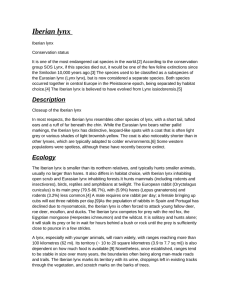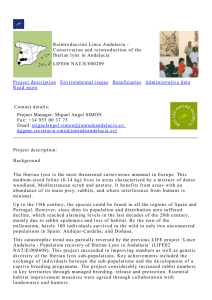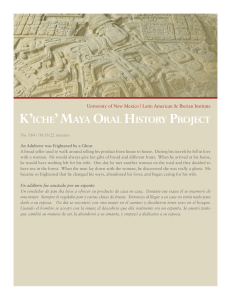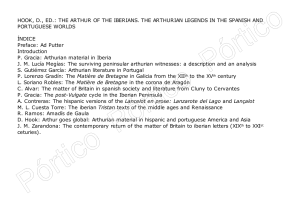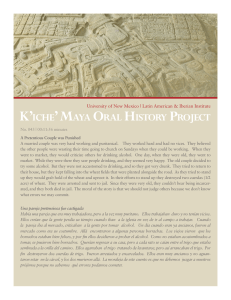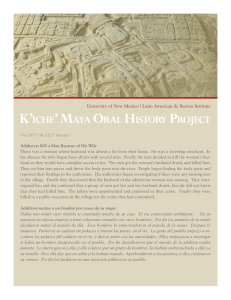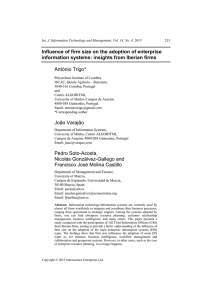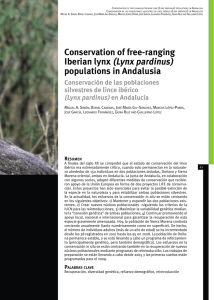A new species of Felicola (Phthiraptera: Trichodectidae) from the
Anuncio
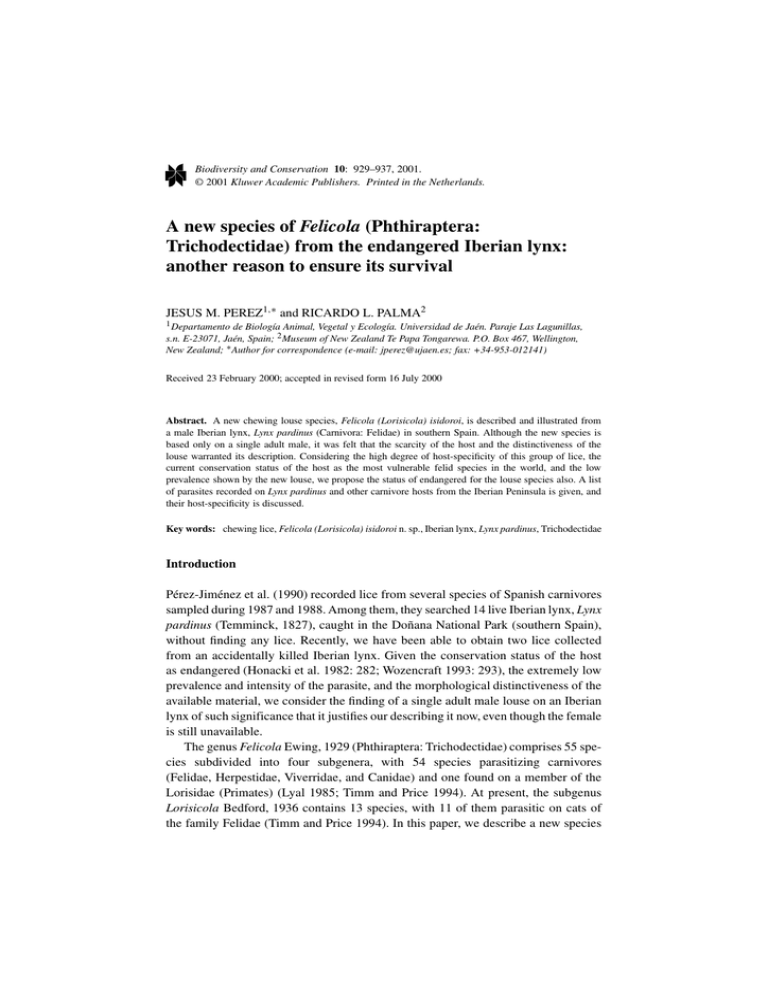
Biodiversity and Conservation 10: 929–937, 2001. © 2001 Kluwer Academic Publishers. Printed in the Netherlands. A new species of Felicola (Phthiraptera: Trichodectidae) from the endangered Iberian lynx: another reason to ensure its survival JESUS M. PEREZ1,∗ and RICARDO L. PALMA2 1 Departamento de Biología Animal, Vegetal y Ecología. Universidad de Jaén. Paraje Las Lagunillas, s.n. E-23071, Jaén, Spain; 2 Museum of New Zealand Te Papa Tongarewa. P.O. Box 467, Wellington, New Zealand; ∗ Author for correspondence (e-mail: [email protected]; fax: +34-953-012141) Received 23 February 2000; accepted in revised form 16 July 2000 Abstract. A new chewing louse species, Felicola (Lorisicola) isidoroi, is described and illustrated from a male Iberian lynx, Lynx pardinus (Carnivora: Felidae) in southern Spain. Although the new species is based only on a single adult male, it was felt that the scarcity of the host and the distinctiveness of the louse warranted its description. Considering the high degree of host-specificity of this group of lice, the current conservation status of the host as the most vulnerable felid species in the world, and the low prevalence shown by the new louse, we propose the status of endangered for the louse species also. A list of parasites recorded on Lynx pardinus and other carnivore hosts from the Iberian Peninsula is given, and their host-specificity is discussed. Key words: chewing lice, Felicola (Lorisicola) isidoroi n. sp., Iberian lynx, Lynx pardinus, Trichodectidae Introduction Pérez-Jiménez et al. (1990) recorded lice from several species of Spanish carnivores sampled during 1987 and 1988. Among them, they searched 14 live Iberian lynx, Lynx pardinus (Temminck, 1827), caught in the Doñana National Park (southern Spain), without finding any lice. Recently, we have been able to obtain two lice collected from an accidentally killed Iberian lynx. Given the conservation status of the host as endangered (Honacki et al. 1982: 282; Wozencraft 1993: 293), the extremely low prevalence and intensity of the parasite, and the morphological distinctiveness of the available material, we consider the finding of a single adult male louse on an Iberian lynx of such significance that it justifies our describing it now, even though the female is still unavailable. The genus Felicola Ewing, 1929 (Phthiraptera: Trichodectidae) comprises 55 species subdivided into four subgenera, with 54 species parasitizing carnivores (Felidae, Herpestidae, Viverridae, and Canidae) and one found on a member of the Lorisidae (Primates) (Lyal 1985; Timm and Price 1994). At present, the subgenus Lorisicola Bedford, 1936 contains 13 species, with 11 of them parasitic on cats of the family Felidae (Timm and Price 1994). In this paper, we describe a new species 930 of Lorisicola from the Iberian lynx, bringing the total number of species in this subgenus to 14. We also discuss the conservation status of the new species of louse in connection to the future survival of its host. The Iberian lynx has been variously regarded as a full species (Honacki et al. 1982; Wozencraft 1993) or as a subspecies of the Eurasian lynx, Lynx lynx (Linnaeus, 1758) (see Corbet 1978). This taxonomic disagreement has probably contributed to an apparent lack of interest in the future survival of the most threatened cat in the world (Rodríguez and Delibes 1990; Beltrán et al. 1996). A catalogue of Iberian animal parasites, which includes the Iberian lynx, has been published by Cordero et al. (1994). Other authors have studied particular systematic groups of parasites, for example, Torres et al. (1991) and Navarrete et al. (1990) dealt with helminthes, Gil-Collado (1934) with fleas, while Hueli et al. (1991) dealt with ticks. Table 1 gives a list of the endo and ectoparasites recorded from Iberian lynx as well as from other carnivores by these and other authors. Materials and methods In January 1997 an adult male Iberian lynx was killed by a car in the Sierra de Andújar Natural Park (Jaén, southern Spain). The carcass was carried to our laboratory by gamekeepers. It was subsequently deposited at the Estación Biológica de Doñana, Sevilla, Spain (collection catalogue number: EBD 23223). While examining the skin, two lice (an adult male and a nymph) were collected. The lice were fixed, cleared, and mounted as described in Soler-Cruz et al. (1979). The male was compared with males of Felicola (Lorisicola) spenceri Hopkins, 1960 and of Felicola (Lorisicola) americanus Emerson and Price, 1983 held in the K.C. Emerson Museum (Oklahoma State University, Stillwater, Oklahoma, USA) after a preliminary study showed that the genitalia of these two species were morphologically the closest to that of our new species. A comparison against published descriptions of all the other 11 species of Felicola (Lorisicola) was also made. The holotype of the new species has been deposited in the Museo Nacional de Ciencias Naturales, Madrid, Spain. The terminology adopted for the description of the male genitalia is that proposed by Emerson and Price (1983). The taxonomic nomenclature of the hosts cited in this paper follows that used by Wozencraft (1993). Results Felicola (Lorisicola) isidoroi new species Type host: Lynx pardinus Temminck, 1827. The Iberian lynx. Type material: ‘Holotype’ male (Sierra de Andújar Natural Park, Jaén, southern Spain, January 1997). 931 Table 1. Host range of parasites recorded from the Iberian lynx. (Other parasites recorded from carnivores from the Iberian Peninsula, but not from the Iberian lynx, are not included.) Group Species Other host species Digenea Cestoda Brachylaima sp. Hydatigera taeniformis Joyeuxiella pasqualei Felis silvestris Felis silvestris, Vulpes vulpes Mesocestoides litteratus Taenia polyacantha Physaloptera praeputialis Toxocara mystax Felis silvestris Vulpes vulpes Nematoda Felis silvestris Domestic cat, Felis silvestris, Genetta genetta Toxocara canis Dog, Canis lupus, Mustela putorius, Vulpes vulpes, Felis silvestris Spirocerca lupi Dog, Vulpes vulpes, Genetta genetta Siphonaptera Odontopsyllus q. quirosi Vulpes vulpes Acari Boophilus annulatus Mustela nivalis Ixodes (I.) ventalloi Herpestes ichneumon, Meles meles, Felis silvestris, M. nivalis, V. vulpes Ixodes (I.) ricinus M. meles, M. nivalis, V. vulpes Ixodes (P.) hexagonus Dog, V. vulpes, Mustela putorius, M. nivalis, Meles meles, H. ichneumon Rhipicephalus (R.) turanicus Domestic cat, Vulpes vulpes, Meles meles R. (R.) pusillus Dog, V. vulpes, Mustela putorius, M. nivalis, Canis lupus, Martes foina Meles meles, Herpestes ichneumon, Felis silvestris, Genetta genetta R. (R.) sanguineus Dog, Vulpes vulpes, Mustela nivalis, Canis lupus, Meles meles Reference/s Torres et al. 1991 Torres et al. 1991 Reina et al. 1992; Navarrete et al. 1990 Torres et al. 1991 Cordero et al. 1994 Vericad and Sánchez 1973 Cordero et al. 1994; Navarrete et al. 1990 Cordero et al. 1994 Cordero et al. 1994 Gil-Collado 1934 Hueli et al. 1991 Cordero et al. 1994 Hueli et al. 1991 Hueli et al. 1991 Hueli et al. 1991 Hueli et al. 1991; Cordero et al. 1994 Hueli et al. 1991; Cordero et al. 1994 Male: As in Figure 1. Head wider than long (see Dimensions below) with narrow medioanterior indentation, sharply pointed clavi, and sparse setae. Antennal scape enlarged. Pronotum with 2 short lateral setae on each side, and 2 median submarginal setae. Pteronotum with posterior row of short setae. Abdomen with six pairs of large spiracles. Abdominal tergum I without setae. Terga and sterna II–VIII with single row of short setae. Genitalia (Figure 2) with basal plate (or basal apodeme) diverging somewhat towards its proximal end and with short but well sclerotized median rod on its distal end. Fused parameres (parameral arch) with short blunt apical process. Endomeral plate with median indentation on anterior margin, and separated distal tips extending well beyond tip of apical process of fused parameres. 932 Figure 1. Felicola (Lorisicola) isodoroi. Male: dorsal (left) and ventral (right) views. 933 Figure 2. Felicola (Lorisicola) isodoroi. Male genitalia. Dimensions of male holotype (in micrometers): head length (C.L.) 363.6; head width (C.W.) 432.6; cephalic index (C.L./C.W.) 0.84; thoracic length 245.8; thoracic width 379.8; abdominal length 749.5; abdominal width (A.W.) 591.1; total length (T.L.) 1358.9; corporal index (T.L./A.W.) 2.30; genitalia length 363.6; genitalia width (taken at the level of the parameral arch) 160.5; endomeral plate length 121.9. Female: Unknown. Etymology: The new species is named after our colleague and friend, Dr Isidoro Ruiz-Martínez, who recently died in a tragic mountain accident. Discussion Our single male louse clearly belongs to the genus Felicola from the features of its head and genitalia. The presence of six pairs of abdominal spiracles places it 934 within the subgenus Lorisicola (see Lyal 1985: 316, 337). We follow Timm and Price (1994: 117) in regarding Lorisicola as a subgenus of Felicola. This is not the first case in which the description of a new species of Felicola (Lorisicola) is based on a single male specimen. Timm and Price (1994) described the new species F. (L.) oncae from a single male louse collected on a jaguar in Costa Rica. Felicola (L.) isidoroi is readily separated from Felicola (L.) oncae Timm and Price, 1994 by its much smaller size and by its grossly different genitalia (compare our Figure 2 with Figure 2 in Timm and Price 1994: 116). The single male Felicola (L.) isidoroi is slightly larger than males of most of the remaining species within the subgenus Lorisicola. However, with only one specimen available, it is not possible to make a significant comparison. The morphology of the male genitalia shows the best combination of characters to distinguish Felicola (Lorisicola) isidoroi from all the species within the subgenus, and in particular from the members of the felis complex – as defined by Emerson and Price (1983) – where it belongs. In the key to the species of the felis complex published by Emerson and Price (1983: 6), Felicola (L.) isidoroi does not fit either option of couplet 1, because it has an endomeral plate with separate distal tips and a shallow median indentation on its anterior margin. The separated distal tips clearly distinguish Felicola (L.) isidoroi from Felicola (L.) felis (Werneck, 1934), F. (L.) neofelis Emerson and Price, 1983, and F. (L.) braziliensis Emerson and Price, 1983. Further, the shallow median indentation is quite different from those depicted by Emerson and Price (1983) for the same species. In additon, those species do not have a median rod in the distal end of the basal plate (compare our Figure 2 with Figures 2, 6 and 7 in Emerson and Price 1983: 3). Considering the remaining four species of the felis complex – all with separated endomeral distal tips and a median rod in the distal end of the basal plate – Felicola (L.) similis Emerson and Price, 1983 and Felicola (L.) sudamericanus Emerson and Price, 1983 can be distinguished from Felicola (L.) isidoroi by the shape of the fused parameres, including the apical processes, and of the endomeral plate, especially the anterior margins (compare our Figure 2 with Figures 11 and 16 in Emerson and Price 1983: 6, 7). Felicola (L.) isidoroi is morphologically closest to Felicola (L.) spenceri Hopkins, 1960 and Felicola (L.) americanus Emerson and Price, 1983. However, they can be separated from our new species by the shape of their fused parameres including the apical processes and to a lesser degree by the shape of their endomeral plates. The greatest difference is that the distal tips of the endomeral plate of Felicola (L.) isidoroi extend well beyond the tip of the apical process of the fused parameres. Also, the apical process of the fused parameres in Felicola (L.) isidoroi is wider and shorter than in the other two species, and the endomeral distal tips of Felicola (L.) isidoroi are thinner than those of Felicola (L.) spenceri (compare our Figure 2 with Figures 4 and 5 in Emerson and Price 1983: 3). Furthermore, Felicola (L.) isidoroi has no setae on abdominal tergum I, while its closest species have two. 935 Honacki et al. (1982: 281) included five species in the genus Lynx Kerr, 1792, while Wozencraft (1993: 293) recognised only four species in that genus, placing the caracal in a separate genus as Caracal caracal (Schreber, 1776) (Wozencraft 1993: 288). Three Lorisicola species are now known from the four Lynx species: Felicola (L.) spenceri on Lynx canadensis Kerr, 1792, the type host, and on Lynx lynx; Felicola (L.) americanus on Lynx rufus (Schreber, 1777) (see Emerson and Price 1981: 52 and Emerson and Price (1983) for these host-louse associations); and Felicola (L.) isidoroi on Lynx pardinus. The fact that these three species of Lorisicola are morphologically closer to each other than to the remaining species of the subgenus suggests a case of coevolution beginning with their ancestral louse, which parasitised the ancestral lynxhost, and continuing with the descendants of both. Knowledge of the lice possibly living on the caracal would be useful to test this hypothesis further. Among ectoparasites, lice (Phthiraptera) generally show a high degree of host specificity (Price 1980; Marshall 1981; Emerson and Price 1985; Kim 1985). Because lice are obligate parasites, some authors consider that they may have a similar extinction rate as their avian and mammalian hosts (Stork and Lyal 1993). The Iberian lynx harbours different kinds of parasites which have also been reported from other carnivore hosts in the Iberian Peninsula (Table 1). However, Felicola (L.) isidoroi appears to be the only parasite strictly specific to the Iberian lynx, with the probable exception of an unidentified species of the digenean genus Brachylaima (see Torres et al. 1991). Considering that the survival of this felid is seriously endangered and that its louse species shows both a low intensity of parasitism (only two specimens so far) and low prevalence (on one host of 15 searched), we are faced with, at least, two taxa threatened with extinction in the near future. Parasites are usually regarded as pernicious organisms which cause injury, diminish fitness, or transmit disease to their hosts (e.g. Brown et al. 1995; Clayton and Moore 1997), sometimes with a consequential economic loss, and therefore they are eliminated without further consideration. In special circumstances, they may also become a threat to the conservation of endangered host species. For example, Mörner (1992) reported an epidemic of sarcoptic mange affecting several species of carnivores, including the Arctic fox, Alopex lagopus (Linnaeus, 1758), in Sweden. A program to capture and treat Arctic foxes against scabies was carried out in order to avoid the potential risk of local extinction of this host. However, the fact that parasites also constitute an important part of biodiversity is generally ignored (Price 1980; Windsor 1995). Parasites have their own biological and evolutionary value (Rózsa 1992). Parasites play a role of biological control agents contributing to the regulation of hosts populations. For example, Coltman et al. (1999) found that gastrointestinal nematodes exert selective pressure against inbred sheep in a free-living, island population of Soay sheep. By removing less heterozygous host individuals, the parasites increase the genetic variation of the host population (see also O’Brien 2000). Thus, we consider that the extinction of parasites may have a negative effect on the longterm conservation of their host species. Therefore, we suggest that preservation of 936 parasites of endangered host species should be taken into account when recovery programmes are carried out. Future conservation of Felicola (L.) isidoroi depends entirely on the survival of the Iberian lynx (its only known habitat). Therefore, a conservation programme for the Iberian lynx would also benefit its endemic parasitic fauna. Avoiding treatment with insecticides when lynxes are captured and maintained in captivity (except for specific clinical cases) is recommended. Acknowledgements The authors are indebted to the Consejería de Medio Ambiente (Junta de Andalucía) for providing the material used in this study and to M.L. Bueno for helping in the examination of the lynx skin. Also to Don C. Arnold (Oklahoma State University, Stillwater, Oklahoma, USA) for the loan of specimens. Special thanks go to Roger D. Price (University of Minnesota, St Paul, Minnesota, USA) for his critical review of the manuscript. References Beltrán JF, Rice JE and Honeycutt RL (1996) Taxonomy of the Iberian lynx. Nature 379: 407–408 Brown CR, Brown MB and Rannala B (1995) Ectoparasites reduce long-term survival of their avian hosts. Proceedings of the Royal Society of London B 262: 313–319 Clayton DH and Moore J (eds) (1997) Host-parasite Evolution: General Principles and Avian Models. Oxford University Press, Oxford, New York Coltman DW, Pilkington JG, Smith JA and Pemberton JM (1999) Parasite-mediated selection against inbred Soay sheep in a free-living, island population. Evolution 53: 1259–1267 Corbet GB (1978) The Mammals of the Palaearctic Region: A Taxonomic Review. British Museum, Natural History & Cornell University Press, London Cordero M, Castañón, L and Reguera A (1994) Indice – Catálogo de zooparásitos ibéricos. 2nd edn. Universidad de León, León Emerson KC and Price RD (1981) A host-parasite list of the Mallophaga on mammals. Misc. Publ. Entomol. Soc. America 12: 1–72 Emerson KC and Price RD (1983) A review of the Felicola felis complex (Mallophaga: Trichodectidae) found on New World cats (Carnivora: Felidae). Proc. Ent. Soc. Wash. 85: 1–9 Emerson KC and Price RD (1985) Evolution of Mallophaga on mammals. In: Kim KC (ed) Coevolution of Parasitic Arthropods and Mammals, pp 233–255. John Wiley and Sons, New York Gil-Collado J (1934) Sobre dos especies nuevas de afanípteros españoles. Eos 10: 153–160 Honacki JH, Kinman KE and Koeppl JW (eds) (1982) Mammal Species of the World: A Taxonomic and Geographic Reference. Allen Press, Inc. and The Association of Systematics Collections, Lawrence (Kansas) Hopkins GHE (1960) Notes on some Mallophaga from mammals. Bull. Brit. Mus. (Nat. Hist.) Entomol. 10: 77–95 Hueli LE, García P, Delibes M and Beltrán JF (1991) Ixódidos (Acarina: Ixodidae) parásitos de carnívoros del Parque Nacional de Doñana (Huelva, España). Proc. I Symp. Ibér. Garrapatas Ixodoideas y Enfermedades Transmisibles 27 937 Kim KC (1985) Evolutionary relationships of parasitic arthropods and mammals. In: Kim KC (ed) Coevolution of Parasitic Arthropods and Mammals, pp 3–82. John Wiley and Sons, New York Lyal CHC (1985) A cladistic analysis and classification of trichodectid mammal lice (Phthiraptera: Ischnocera). Bull. Brit. Mus. (Nat. Hist.) Entomol. 51: 187–346 Marshall AG (1981) The Ecology of Ectoparasitic Insects. Academic Press, London Mörner T (1992) Sarcoptic mange in Swedish wildlife. Rev. Sci. Tech. Off. Int. Epizoot. 11: 1115–1121 Navarrete I, Habela M, Reina D, Nieto CG, Serrano F, Verdugo SG and Breña M (1990) Parasites of feral carnivores in Cáceres province, Spain. Sond. Verh. 32 Int. Symp. Erkrank. Zoo Wildt., Eskilstuna 229–231 O’Brien SJ (2000) Adaptive cycles: parasites selectively reduce inbreeding in Soay sheep. Trends Ecol. Evol. 15: 7–9 Pérez-Jiménez JM, Soler-Cruz MD, Benítez-Rodríguez R, Ruiz-Martínez I, Díaz-López M, PalomaresFernández F and Delibes-de Castro M (1990) Phthiraptera from some wild carnivores in Spain. Sys. Parasitol. 15: 107–117 Price PW (1980) Evolutionary Biology of Parasites. Princeton University Press, Princeton, New Jersey Reina D, Habela M, Serrano F, Nieto CG, Breña M, Pérez E and Navarrete I (1992) Contribución al conocimiento de la parasitofauna de los animales silvestres y de vida libre en la provincia de Cáceres (España). In: Hernández S (ed) In Memoriam al Prof. Dr. D. F. de P. Martínez Gómez, pp 407–428. Universidad de Córdoba, Córdoba Rodríguez A and Delibes M (1990) El Lince Ibérico (Lynx pardina) en España. Distribución y Problemas de Conservación. ICONA-CSIC, Madrid Rózsa L (1992) Endangered parasite species. Int. J. Parasitol. 22: 265–266 Soler-Cruz MD, Martín-Mateo MP and Morillas-Márquez F (1979) Brüelia parviguttata (Blagoveshchensky, 1940) (Mallophaga) parásito de Galerida cristata L. Rev. Ibér. Parasitol. 39: 165–173 Stork N and Lyal CHC (1993) Extinction or ‘co-extinction’ rates? Nature 366: 307 Timm RM and Price RD (1994) A new species of Felicola (Phthiraptera: Trichodectidae) from a Costa Rican jaguar, Panthera onca (Carnivora: Felidae). Proc. Biol. Soc. Wash. 107: 114–118 Torres J, Casanova JC, Feliu C, Miquel J, Gisbert J and García-Perea R (1991) Biogeografía de los helmintos parásitos de félidos silvestres en la Península Ibérica. In: Mas-Coma S et al. (eds) Parasitología en el Sureste de Europa, pp 24. J. Aguilar, SL, Valencia Vericad JR and Sánchez C (1973) Endoparásitos de aves y mamíferos del Alto Aragón (Huesca). Rev. Ibér. Parasitol. 33: 267 Windsor DA (1995) Equal rights for parasites. Conserv. Biol. 9: 1–2 Wozencraft WC (1993) Order Carnivora. In: Wilson DE and Reeder DM (eds) Mammal Species of the World: A Taxonomic and Geographic Reference, pp 279–348. 2nd edn. Smithsonian Institution Press, Washington, DC
